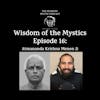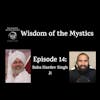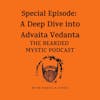Thoughts on the Bhagavad Gita: (Chapter 13: Verses 1 - 7)
This episode discusses the 13th chapter of the Bhagavad Gita, specifically verses 1 - 7.
Translation used: The Bhagavad Gita Comes Alive: A Radical Translation by Jeffrey Armstrong
If you enjoyed listening to the 84th episode of the Thoughts on The Bhagavad Gita and want to listen to more episodes like this on the Bhagavad Gita, or on Non-Duality, or the wisdom of the Mystics please follow/subscribe to this Podcast. New episodes are uploaded every Sunday.
Thoughts on the Upanishads, Conversations with the Bearded Mystic, Guided Meditations, and much more only on Patreon, Buzzsprout Subscriptions, Apple Podcast Subscriptions and Supercast.
Patreon: Support The Bearded Mystic Podcast and get ad-free, bonus episodes along with many more benefits:
https://www.patreon.com/thebeardedmysticpodcast
Buzzsprout Subscriptions: Support The Bearded Mystic Podcast and get ad-free, bonus episodes: https://www.buzzsprout.com/1800416/subscribe
Direct & Unfiltered with The Bearded Mystic is a great format to ask The Bearded Mystic (Rahul) whatever question you have in your mind. Submit your question by completing this survey please.
Join The Bearded Mystic Podcast Discussion Group on Whatsapp: https://chat.whatsapp.com/GcCnyrjQwLuEPHBaVA6q9L
Be notified of my weekly virtual meditation session followed by a Q&A Discussion via zoom (Notifications only):
https://chat.whatsapp.com/DcdnuDMeRnW53E0seVp28b
If you would like a one-on-one meeting with me via Zoom, book here:
https://calendly.com/thebeardedmysticpodcast/1on1meetings
Please rate and write a review for this Podcast: https://www.thebeardedmysticpodcast.com/reviews/new/
You can follow me and contact me on social media:
Website: https://www.thebeardedmysticpodcast.com
TikTok: https://vm.tiktok.com/ZMdk3HPJh/
Instagram: https://www.instagram.com/thebeardedmysticpodcast/
Youtube: https://www.youtube.com/c/TheBeardedMysticPodcast/
Twitter: https://twitter.com/bearded_mystic
Facebook: https://www.facebook.com/The-Bearded-Mystic-Podcast
Rahul N Singh:
Hello and welcome to The Bearded Mystic Podcast and I'm your host Rahul N Singh. Thank you for taking out the time today to either watch or listen to this podcast episode. If you are really interested in supporting The Bearded Mystic Podcast, and you've found great benefit in listening or watching these episodes, then please do support this podcast on Patreon where you can get ad free and bonus episodes along with other benefits depending on the tier that you select. Your support means everything, and it really does help the podcast keep running efficiently and smoothly, and also widens the audience that this message can reach to. If you would like to know more about it, the details are in the show notes and video description below. On Saturdays at 11:00 AM Eastern Standard Time there is a free virtual meditation session along with discussion and Q&A. If you're interested in meditating with us as a community, then you can find out the details in the show notes and video description below. Please do like, comment, and subscribe if you're watching this on YouTube and if you're listening to this on your favorite podcast streaming app, then please do give this podcast a five star rating. It helps the podcast get up in the charts and allows the algorithm to bring this podcast to new listeners and also do review the podcast if you can and make sure you do follow or subscribe to keep getting future episodes. Today we will be continuing on with my thoughts on the Bhagavad Gita and today we will be starting chapter 13 looking specifically at verses 1 to 7 but this particular chapter is about the knower and the field and it's knowing about the discrimination or the discernment between the two. So there's a lot to discuss, a lot to go through and a lot to discover as we go deeper into The Bhagavad Gita and its message. Verse one. Arjuna spoke: O Sri Krisna, I wish to understand prakriti, the material nature, Purusha, the transcendental person who is the source of matter, Kshetra, the energetic field of matter, kshetrajna, the conscious beings who are the knowers of that field, jnana, the knowledge itself and jneya, the purpose of that knowledge. So there's a lot that we have to discover here and Arjuna wants to know what these five things are. This is what's the base for the whole chapter and now Sri Krisna will explain that to him. Sri Bhagavan said, those who truly understand proclaim that the five element body is known as the kshetra, the field of activity, and the conscious perceiver within the body is called kshetrajna the knower of that field of action. Let's break that verse up a little. We will not go in depth right now because there's going to be further explanations as we progress through the chapter. So let's look at the first part. Sri Bhagavan said, those who truly understand, proclaim that the five element body is known as Kshetra, the field of activity. So first of all, this is an important verse and one again that we should contemplate on. The first point is that we should understand what is necessary. This is an interesting verse that Sri Krisna starts off with. He says, those who truly understand proclaim. So first of all, he's making a statement about people who know, people who understand, people who actually know what they're talking about spiritually. Now, the important thing is, even within Hinduism, or Vedanta, there has been a obviously, an inquiry into not only the observer, but the observed, meaning nature, meaning things, objects, this whole universe. So, what Sri Krisna is already saying is that the person who truly understands, knows about the field of activity, the Kshetra. The Kshetra and then the kshetrajna is the knower of that very field of action, that very field of activity. In this particular part of the verse, he says that this field of activity, first of all, for all of us, is this five element body. Yeah, the way we are able to make sense of the world is through the body first. Right, so the body performs the action, we know this, it is without, without the body, there is no action. We know that the mind is housed in the body, hence thoughts and emotions are activities of the body. And then we have the panj koshas, the five koshas, the five sheaths. They are also within the body So you have the physical body, you have prana. You have the mind or Manas, then you have intellect, and then you have the anand, the bliss sheath. And then he says in the second part And the conscious perceiver within the body is called kshetrajna the knower of that field of action. So that is now the awareness within the body, the observer within the body. So the observed is the field, the observer is within the body. It's the one that is present within and that is known as the knower of the field of action. So it seems to be aware and alert of everything that happens around it. Yeah, so whatever it observes as an object, It remains as a subject, witnessing it all, as the body, with all its activities performed, the witness consciousness just watches. This is what we can understand just from this very short introduction and that's what the wise ones understand. So we know that this is the people of wisdom who have understood this very simple, yet this very honest and radical truth. Then in verse 3, Sri Krisna says, O Arjuna, I am the supreme knower of the fields which are all bodies. In my opinion, knowing this is true and complete knowledge. Let's break this down. What you're going to get with chapter 13 is just verses that are amazing. Like they are mind blowing verses. To truly understand Sri Krisna, And his message in the Gita, verse 13, is, in my opinion, just as important as chapter 2. So, there's a lot of importance on this chapter, and specifically the verses that are in here. So first of all, let's break this up. He says, Oh Arjuna, I am the supreme knower of the fields, which are all the bodies. So, that same awareness in your body, Is the supreme knower of all the bodies in the universe, so every living entity, animate and inanimate, whether they are living entities or they appear not to be living, so, you know, rocks, stones, and what we think is still, but actually it has life in there. Those are bodies, right? You have the elements, you have this world, you have the many, many people in the world, you have the trees, you have the animals, you have the insects, you have all those living creatures, then you have the universe with all its wonders and celestial bodies. He's saying here that... Oh Arjuna, I am the Supreme Knower of the fields which are all bodies. So every single, being that you see, every single field that we are considering here, I am all of those. I am the supreme knower of those fields. Remember from the last verse, is about the Supreme Knower within. The kshetrajna of all the other fields. So this is the unique message here. While we may know only one body which is our own, Sri Krisna says Brahman is the knower of all the fields, all the forms in existence. Here is where Advaita takes its place, that Brahman is the supreme witness consciousness within, and is the same One within everyone, although everything else appears to be different. Every single body is different and unique, yet, the one thing that remains the same is the Knower of that Field. And that knower of the Field, although it appears to be different awarenesses or different consciousnesses in different beings, actually it's just that One Same Consciousness. Because it's that one same Satchitananda. Then he says, in my opinion, knowing this is true and complete knowledge. Look at that, within verses two and three he has established what is the truth. So Sri Krisna says that knowing this is enough. If you know the knower and the field, you're, you're done in terms of spiritual realization. You're, you got there. Yeah, so, this is everything one needs to know. This is the Ultimate Truth. If we can grasp this, and we can take it with us in our day to day life, we are literally singing our way to mukti. This is how great it is. So this is a complete truth. He says it's a complete knowledge, there is nothing as perfect and complete as this. This is the Gyan that we're talking about. This is the knowledge of Vedanta. Let's break this down a little so we can understand how that is. You have a body. This body is full of activities. So, the senses produces activities. You have the mind that interprets these activities, the intellect that discerns between what is true and not true, and what is the right thing to do, and what's not the right thing to do. What does it feel like to be in pain or pleasure and going through those activities, that's what happens in the body and even with the senses. So it's the eyes, it's in the ears. What do the eyes do? The eyes see. The ears hear, the tongue tastes, the nose smells, the skin touches, so all of these things have an activity. Then, there is a witness within the body, so for example, even though the eyes are seeing, I am aware of the eyes that are seeing, I am aware of the ears that are hearing. Not only that, I'm aware of the hearing and the ears. I'm aware of the eyes and the seeing. I'm aware of the taste as well as the tongue. I'm aware of the smell as well as the nose. So this is the unique aspect of what the human being has as a witness. So I'm the witness of even my thoughts. I'm the witness of my emotions. I'm the witness of my intellect. When I make the choices, I'm aware. I'm that silent awareness between the discerning aspect. The discernment between two choices. This witness is silent and changeless observer of'I am' in every activity throughout your life. This very witness'I am' is the universal'I am'. It is the same silent and changeless observer in every object of this existence. The universal'I am' is Formless Awareness, which is beyond this existence and this existence is merely a small thought in this Infinite Formless Awareness. This is what is the complete knowledge. That's, that's it. Sri Krisna has made it very clear, but we always need more explanation. We need to know more. We need to express these ideas more, we need to flesh out these ideas and Sri Krisna is going to help us here. So he says, and now Arjuna, listen to me as I describe a brief summary of that Kshetra, that field, yeah? What its variations are, what impels those transformations, who Prabhava, the ultimate knower, is, and what is the extent and nature of the powers of that Being. So Sri Krisna says he's going to provide a very brief summary. He's not going to go into incredible detail, but he's going to explain enough that this knowledge can be understood and really imbibed into our life, like we can actually live it. The reason for this is to ensure there is understanding. If you don't understand this, then we have to keep going back and studying it and studying it. And we don't have to study the text. We can study our own self, we don't need to go very far, yeah, the knower is here, the field is also here and there, around us, yeah, so it's not like we have to go out to the mountains to discover this truth. That's why the Bhagavad Gita is perfect for householders because it's not about renouncing the world, in fact it's more about embracing the world because it's that one same truth. Sri Krisna also understands that we need not only repetition, but further explanations too. Even though some things may be repetitive, it's very important that we also have further explanations. Sri Krisna may repeat himself only to go deeper. And this is why listening to these texts, reading these texts, reading the commentaries, understanding them, is so important. A lot of people just are satisfied with listening or knowing and being able to recite it, but living it. Experiencing it, having the anubhav, the actual experience, is so much more important. And this chapter tells us very simply how to actually experience it. And you know what, we've been experiencing this our whole life, but we did not know this. We were not aware of that. Sri Krisna says: In the Vedic texts, many great rishis have sung of these truths regarding the characteristics of Brahman and Prakriti. They are also explained in the Brahma Sutras with profound reasoning, and precise logical inquiry. So let's look at the first part. In the Vedic texts, many great rishis have sung of these great truths regarding the characteristics of Brahman and Prakriti. Now this is in regards to the Upanishads. Remember one thing, that the Bhagavad Gita is the cream of the Upanishads. Now, If you want to understand how this is the cream and to truly understand the Bhagavad Gita it's very essential to understand the philosophy of the Upanishads, of Vedanta. If we do not do this, then we are not going to understand the Bhagavad Gita. Simple as that. And many wrong interpretations have occurred because nobody goes back to The Upanishads. Like they'll select a few Upanishads that support their crooked theories, but they won't look at the constant and consistent message that's throughout each Upanishad. Now, so he says in the Vedic text, many great rishis have sung of these truths. You'll find many lines in the Upanishads that will hint upon these very concepts, like the one from the many. The one is manifested in many. You'll see so many explanations and kind of expositions and incantations and chants of this truth of the one and the many. And that how the one is the many, is it appears as many, but it's actually the One. So this is what Is being discussed here. And then he says, regarding the characteristics of Brahman and prakriti. He will emphasize that the truth is non-dual and it's completely advaita vedanta. It's completely non-dualistic. This is the philosophy, this is the truth. Now, one thing we'll also add is that it's gonna go through prakriti, which again is beginningless. Yeah, it's complete in itself and Brahman is complete in itself. The only, remember through the Sankhya philosophy, these two things are different. So you'll have Purusha and you'll have prakriti. Now Purusha, in Sankhya philosophy, there's many Purushas. Yeah, there's many living witness consciousnesses. But in Vedanta, they take it a step forward. There's an evolution where they say actually there's only one witness consciousness even though it appears that there's many and these objects are actually just an appearance, a reflection from that One Pure Consciousness, that one pure awareness. So this is what's being expressed here. And he's saying the Vedic texts basically explain this. So if you don't believe me, go read the Upanishads. Then he says, they are also explained in the Brahma Sutras with profound reasoning and precise logical inquiry. Now, one thing I will say is that the Brahma Sutras have to be read, they're one of the three important texts of Vedanta, which is obviously the Upanishads, the Bhagavad Gita and Brahma Sutras, so what one should do is read the Upanishads, read the Brahma Sutras and then read the Bhagavad Gita. That's my personal method. Reason being, is that once you have logic and reasoning as your base and then transcendent of that, then the Bhagavad Gita makes a lot of sense. Otherwise, if we don't read the other two... you will find that people will not understand the Gita properly. What I do suggest is that the Brahma Sutras are read and at least five verses in the beginning of the Brahma Sutras should be read along with their commentaries by Adi Shankara Ji or Swami Sivananda Ji or anyone that we really look up to. And the Brahma Sutras are very terse aphorisms, very terse, very small sutras and they require a lot of understanding required before reading them. That's why Even to go a step further and say you want to truly understand Vedanta then I would say read one of the preliminary texts like Tattvabodh or Atmabodh or Aparokshanubhuti, anything by Adi Shankara Ji that will help us. And reading the commentaries of Adi Shankara Ji is very very important. So that's something I will want to raise and make sure that we do practice. Then verse 6. The field and its various modifications consist of Panch Mahabhutas, the five great elements, the ahamkara, the faculty that identifies the Atma with matter. Buddhi, which is the ability to discern what is prakriti and what is not, avyakta, the great unmanifest reality, dasha indriyas, the ten senses, five perceptive and five active. Manas, the faculty that performs the tasks of thinking, feeling, willing or desiring, and memory, and the indriyas gocharas, the objects of the ten senses. So we're going to go into this very, very quickly, but enough for us to understand. First of all, Sri Krisna is talking about the field, yeah, and the field and its various modifications. He's not talking about the Purusha or Brahman yet. He says the field and its various modifications consist of the Panch Mahabhutas, which is the five elements, and ahamkara, the faculty that identifies the Atma with matter. So let's understand what this field is made of. So one is the five great elements which are fire, air, earth, water and space. Not ether, I just want to say because I know some translations use the word ether. Akash is space, not ether. And then the Ahamkara, the faculty that identifies the Atma with matter. You have the Atma, you have the jiva-atman, which is Brahman, this witness consciousness, this pure consciousness, this formless awareness. Now what happens is, when this formless awareness is identified with a personal I, with an individual, and thinks that, well, this body is all that I am, then that is called the ahamkara, that's the individual personal I. That's created when the Atma or the Jiva associates with that matter in particular. So that can be any form of body that we have, subtle or physical. Then you have buddhi the ability to discern what is prakriti and what is not, and avyakta the great unmanifest reality. So Buddhi is there to help us discern between the Real and the unreal. Remember, the real is that which is changeless and the unreal is that which is changing. To understand what is sat and asat, true and false, and to understand what is permanent and impermanent. So nitya and anitya. The field is also this great unmanifest reality, this avyakta meaning all of this field contains this pure consciousness. This is where you start seeing aspects of it. So you could see it as The void or the space, that is larger than the space that's within the body, but the space that is all around us. So although it looks like there's nothing in this space, it actually has things, it's not manifested in terms of how our senses perceive it. Our senses don't have the, the capacity to see what's within that space. But I normally call it the emptiness or shunya or void and that's just an easier way to explain it. And then you have the dasha indriyas, the ten senses, five perceptive and five active. Manas, the faculty that performs the tasks of thinking, feeling desiring and Memory, and Indriya Gocharas, which is the objects of the ten senses. Let's go into what that is. You have the dasa indriyas, which are senses of Gyana and karma. Gyana is the knowledge or perceptive, which is ears, skin, eyes, tongue and nose. And then you have the karma, which is the action or the active. And that is speech, which is through voice. Grasping, which is through hands and walking, which is through feet. Excretion, which is done through the anus. And procreation, which is done through the genitals. So those are the dasa indriyas. Then you have the Manas, which is the mind. Now the mind does the task of thinking. So with thought, feeling, with emotion, desiring, with wanting something, and memory, thinking of the past. And even, I would say imagination, which will be in the desiring aspect of the future. So then you have the objects of the five senses, which are the eyes can perceive only forms, the ears can listen only to sounds, the nose can only smell, the tongue can only taste, and the skin can perceive whatever it touches. It can't go beyond that. For example, the ears will never be able to see, and the eyes will never be able to hear. Right? The function remains rather limited and they remain in that way. They don't go beyond those objects. Therefore you have the five subtle elements which we've just mentioned and then you have the ego and intellect. These seven are the prakriti, vikriti, which is the primordial matter, which is prakriti. Then you have the ten senses, the mind and five objects of the senses. These 16 are vikriti. These 24 elements constitute the kshetra, the field. And basically just a small, minute portion of this field is this human body that we think is everything, which has been termed as the sarira, the body. These are literally what constitutes the body. Then, verse 7. Which is the final verse, which will look into the modifications within the field of this body. So you have, iccha, which is desire, hunger and inclination for material pleasure. Dvesha, or aversion, repulsion and disinterest in matter or the world. Sukha, which is the pleasure, enjoyment and happiness within matter. Dukha, which is pain, unhappiness and repulsion to matter or the world. Samghata, the entire holistic material manifestation of the body mind complex. Chetana, the life force and awareness that pervades that body. Driti, the steady manifestation of that body as a complex arrangement of matter functioning according to the gunas and doshas and all these are the knowledge of the field and it's various modifications. So, let's break this verse up and let's look at these modifications of the field. First of all, you have Iccha. Iccha is that part of the field that is always desiring something material and chasing those desires. So, you know, whether that's desire itself, whether it's hunger for more and there's no, no satisfaction, you just keep wanting to consume more. Or you see someone else have something that you do not have and how you want it, and there's this constant battle within that you, you wanna get what they have. Your mind generally steers towards the material and one's attention is always materialistic. So the inclination there, the, the kind of nature, the, the hukam the natural way of the body is to go towards the material pleasure. Then you have the dvesha, which is aversion, repulsion, and disinterest in material. At the same time, we may have an aversion to the world and, and this creates this disdain and this disinterest in, in worldly matters. One gets repulsed by different parts of nature and wants to separate from that nature and others will get disinterested and therefore they do not look to care for the world, they don't care how the world is going to be, they don't care about nature and how, you know, kind of nature is being affected by human behaviour and they don't care about other living beings. Those are some of the modifications in the field. Then you have Sukha and Dukha. This field contains pleasure through various means like food, drink, or you know, even buying on Amazon or things that we see on social media. The enjoyments of the world is aplenty, and you know, it can be things like travelling, or doing some adventurous activity, or eating our favourite foods, and, you know, literally doing anything that just creates a lot of enjoyment within this material world. One finds things in the world that makes them happy, like if they get a gift that they want, or they get an item that they want, or a product that they want. It could be a car, it could be a house, it could be children, offspring, it could be the job they want, and so forth. One can find pain also in this world, like losing a loved one, losing wealth or they have an injury or disease. One can be unhappy with the world because society isn't looking after them. The government just cares about its own interests and doesn't care about yours or mine or anyone else's. And repulsion to anything that gives pain in the world, there is avoidance of addressing our fears and or we avoid those that may cause momentary pain. That can become our nature where we want to avoid just actually dealing with pain and actually doing something about it. We rather just forget about it. And, you know, there's this aversion, this repulsion to actually do something about transcending that sadness or pain or anger. Then you have samgata, the entire holistic material manifestation of the body mind complex and chetana, the life force and awareness that pervades the body. So, that 24 elements in the body that we just discussed before, when it's functioning as one whole, is part of the field. That is the samgatha when it's all one unity. And then you have the chetana awareness that pervades the body, which is a conscious element, which is very real, which is what we feel right now, that is aware of everything going on in the body-mind complex, and is even aware of what is going on around it. So not just within the body, but also around the body. It is also the life support because without it, we wouldn't be alive. It's impossible to be alive. It's very, very necessary for that chetana to be there. It's like the prana, without that breath, we just cannot survive and the awareness is just within the body and also related to the field, somehow, and how it's related to the field is what Sri Krisna will talk about later, but again, all these are just modifications. Then you have Dhriti, which is the steady manifestation of that body as a complex arrangement of matter functioning according to its gunas and doshas. So the body is modified according to the gunas, the three gunas, yes, sattva, rajas, and tamas, and doshas. However, the body is kept assembled as it is. With these elements, or with these gunas, this material nature, the body is kept as it is. Although the body will age, the strength of the body will reduce. That's what happens according to the gunas and doshas. And then he concludes that all these are the knowledge of the field and its various modifications. So this is what the knowledge of the field is. And it's various modifications and this is how we distinguish between the field and the know of the field. So you have that chetana, yeah, that awareness. So all the above are objects that awareness is aware of. It's an insight that is understood when we truly start learning about Vedanta and start benefiting from the teachings and lessons from Vedanta. So, there's a lot more to discuss within the next couple of episodes, especially with this chapter. So... I look forward to seeing you in the next episode. Thank you very much for listening and that is the end of the episode. If you liked what you heard and liked what you watched, please do share this podcast with your friends and family who may enjoy this content. Do follow me on social media to keep getting updates. Join the Bearded Mystic Podcast WhatsApp community group to continue the podcast discussion, details are in the show notes and video description below. If you would like to support the Bearded Mystic Podcast as we discussed earlier, do check out the podcast Patreon page. Your support means everything, and it helps this podcast keep running. Details are in the show notes and video description below. Please do rate this podcast five stars and do give a review either on your favorite podcast, streaming app or on our website. Details are in the show notes and video description below. Please do like and comment on this video and subscribe to this YouTube channel. Do follow or subscribe to this podcast on your favorite podcast streaming app. Thank you very much for listening to this episode. Let's end with the Shanti mantra and the Soham mantra. Soham Soham. I am That. I am That. Aum Shanti Shanti Shanti Aum Peace Peace Peace Namaste.
New to The Bearded Mystic Podcast?
Here are some great episodes to start with. Or, check out episodes by topic.















